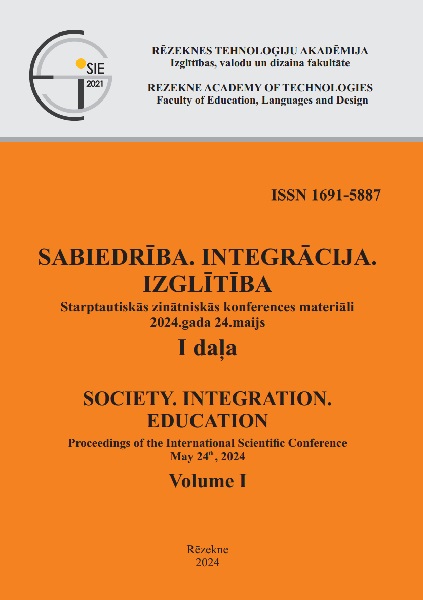MOTIVATION OF CRIMINAL ACTIVITIES OF PERSONS COMMITTING HATE CRIMES AND PREVENTION STRATEGIES
DOI:
https://doi.org/10.17770/sie2024vol1.7897Keywords:
hate crime, motivation, prevention strategies, role of educationAbstract
The study aims to analyze the motivation of hate crime perpetrators to commit a hate crime and to analyze the possibilities for preventing hate crime in the context of education. The study's tasks are to find out what motivating factors a person has in committing hate crimes aswell as analyze the role of hate as an emotion in committing crimes. The role of education and the opportunities offered through education to reduce hate crime will also be assessed. The focus of the study is based upon the increasing focus of the European Union on reducing hate crimes in the Member States and the high impact of education on personal development, which can be a determining factor in a person's tendency to commit crimes. The results of the study will be able to be used in educational institutions to gain more detailed insights into factors motivating hate crimes so that pedagogical approaches can be developed and improved in order to reduce the tendency of individuals to commit hate crimes. The study will use the descriptive method to describe the personality and motivation of hate criminals to commit hate crimes, as well as a data analysis to draw conclusions about factors motivating crime.
References
Baumanis, J. (2017). No krimināltiesību normu interpretācijas līdz kvantu kriminoloģijai. Rīga: Latvijas Vēstnesis.
Burt, C.H., Simons, R.L. (2013). Self-Control, Thrill Seeking, and Crime. SAGE Publications. 40(11), 1326-1348. DOI: https://doi.org/10.1177/0093854813485575
Cramer, R.J., Cacace, S.C., Sorby, M., Adrian, M.E., Kehn, A., Wilsey, N.C. (2023). A Psychometric Investigation of the Hate-Motivated Behavior Checklist. Journal of Interpersonal Violence. 38:7-8, 5638-5660. DOI: https://doi.org/10.1177/08862605221127196
Dupate, K. (2023). Naida noziegumi un naida runa. Pieejams: https://dspace.lu.lv/dspace/bitstream/handle/7/64849/Naida_noziegumi_un_naida_runa_2023.pdf?sequence=1&isAllowed=y
Eiropas Savienības Pamattiesību aģentūra. (2021). Encouraging hate crime reporting: the role of law enforcement and other authorities. Retrieved from: https://data.europa.eu/doi/10.2811/303805
Eiropas Savienības Pamattiesību aģentūra. (2009). Naidīgie izteikumi un noziegumi, kas izdarīti uz naida pamata pret LGBT personām. Pieejams: https://fra.europa.eu/sites/default/files/fra_uploads/1226-Factsheet-homophobia-hate-speech-crime_LV.pdf
Entorf, H., Lange, M. (2023). Regional Science and Urban Economics. Refugees welcome? Understanding the regional heterogeneity of anti-refugee hate crime, 101 (103913). DOI: https://doi.org/10.1016/j.regsciurbeco.2023.103913.
European Commission. (n.y). Extending EU crimes to hate speech and hate crime. Retrieved from: https://commission.europa.eu/strategy-and-policy/policies/justice-and-fundamental-rights/combatting-discrimination/racism-and-xenophobia/extending-eu-crimes-hate-speech-and-hate-crime_en
Groma, J. (2018). Preventing and combating hate crimes: Modern approach. 6th International Interdisciplinary Scientific Conference Society. Health. Welfare, pt II. 51(01009). DOI: https://doi.org/10.1051/shsconf/20185101009
Izglītības un zinātnes ministrija. (2024). Noskaidrots Latvijas jauniešu viedoklis par iekļaujošu sabiedrību. Pieejams: https://www.izm.gov.lv/lv/jaunums/noskaidrots-latvijas-jauniesu-viedoklis-par-ieklaujosu-sabiedribu
Jaunatnes lietas. (2024). Eiropas Jaunatnes dialoga (EJD) jauniešu vēstnieku īstenoto konsultāciju viedokļu apkopojums EJD 10. ciklā. Pieejams: https://jaunatneslietas.gov.lv/sites/default/files/editor/EJD%20_Konsultaciju_apkopojums_web.pdf
Likona, T. (2000). Bērna audzināšana. Rīga: Avots
LR Saeima. (1998). Krimināllikums. Latvijas Vēstnesis, 199/200, 08.07.1998.; Latvijas Republikas Saeimas un Ministru Kabineta Ziņotājs, 15, 04.08.1998. Pieejams: https://likumi.lv/ta/id/88966-kriminallikums
McDevitt, J., Levin, J., Bennett, S. (2002). Hate Crime Offenders: An Expanded Typology. Journal of Social Issues 58(2), p303. DOI: https://doi.org/10.1111/1540-4560.00262
Satversmes Sapulce. (1922). Latvijas Republikas Satversme. Latvijas Vēstnesis, 43, 01.07.1993.; Latvijas Republikas Saeimas un Ministru Kabineta Ziņotājs, 6, 31.03.1994.; Valdības Vēstnesis, 141, 30.06.1922. Pieejams: https://likumi.lv/ta/id/57980-latvijas-republikas-satversme
Steinberg, A., Brooks, J., Remtulla, T. (2003). Youth Hate Crimes: Identification, Prevention, and Intervention. American Journal of Psychiatry. 160(5) 979-989. DOI: https://doi.org/10.1176/appi.ajp.160.5.979
Thompson, N. (2019). ‘It’s a No-Win Scenario, either the Police or the Gang Will Get You’: Young People and Organised Crime – Vulnerable or Criminal? SAGE Publications. 19(2), 102-119. DOI: https://doi.org/10.1177/1473225419843353
Treļs, E. (2019). Naida noziegumi Latvijā: kriminālatbildība un piemērotie sodi. Socrates: Rīgas Stradiņa universitātes Juridiskās fakultātes elektroniskais juridisko zinātnisko rakstu žurnāls. 1(13), 30–41. DOI: https://doi.org/10.25143/socr.13.2019.1.030-041
UNESCO. (2023). Addressing hate speech through education: a guide for policy-makers. Retrieved from: https://unesdoc.unesco.org/ark:/48223/pf0000384872
Valsts policija. (b.g.) Valsts policijas 2022. gada pārskats. Pieejams: https://www.vp.gov.lv/lv/media/15759/download?attachment
Wachs, S., Wettstein, A., Bilz, L., Krause, N., Ballaschk, C., Kansok-Dusche, J., & Wright, M. F. (2022). Playing by the Rules? An Investigation of the Relationship Between Social Norms and Adolescents’ Hate Speech Perpetration in Schools. Journal of Interpersonal Violence. 37(21-22), NP21143-NP21164. https://doi.org/10.1177/08862605211056032






